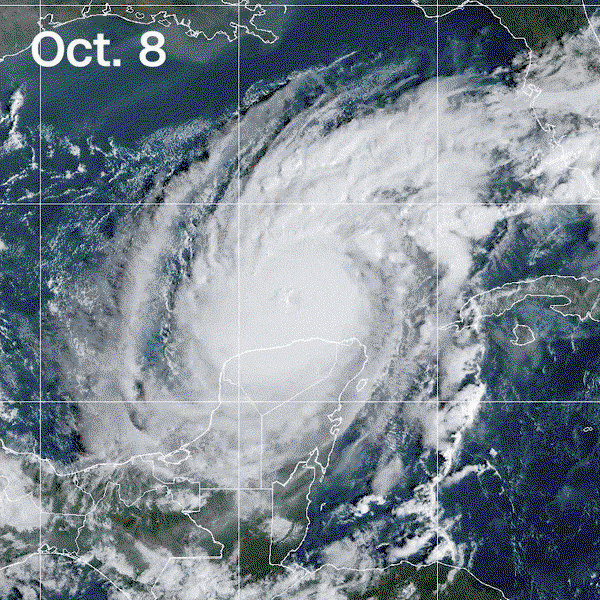Maps and charts: Visualizing Milton’s historic impact across Florida

By Amy O’Kruk, Matt Stiles, Renée Rigdon, Curt Merrill, Soph Warnes and Annette Choi, CNN
(CNN) — Hurricane Milton slammed into Florida’s Gulf Coast on Wednesday night, making landfall as a powerful Category 3 storm. The intense hurricane spawned tornadoes, dumped rain across much of the state, left millions without power and claimed at least 16 lives, including five people in St. Lucie County.
As the storm has moved into the Atlantic Ocean, roughly 10 million residents remain under threat from dangerous coastal conditions through Friday. The storm’s dramatic and rapid intensification set a record as the fastest-ever Atlantic hurricane to escalate from a tropical depression to Category 5 status in just over 48 hours, according to NASA.
Milton’s sustained wind speeds peaked at 180 miles per hour on Monday, before dropping to around 120 mph when the storm made landfall near Siesta Key around 8:30 p.m. Wednesday — less than two weeks after Hurricane Helene made landfall in the state as a Category 4 storm.
Milton is the third hurricane to hit Florida this year — which has only happened during five other hurricane seasons since 1871. No season on record has had more than three hurricanes strike Florida.
Extremely warm water in the Gulf of Mexico acted like rocket fuel for the hurricane, a phenomenon that’s been made hundreds of times more likely by climate change, according to a recent analysis by nonprofit research group Climate Central. Satellite data shows that sea surface temperatures in the gulf are around 1 to 3 degrees Celsius warmer at this time compared to the long-term average for 1985 through 2012.
More than 18 inches of rain fell in St. Petersburg, marking a 1-in-1,000 year rainfall event. Flooding is still expected through the weekend. See where the heaviest rain hit the state:
While Milton’s prolific rain is causing major flooding and swelling rivers to historic highs in some places, FEMA Director Deanne Criswell said Florida dodged the worst-case scenario. Relief efforts are ongoing, including a rescue of at least 135 peoplefrom an assisted living facility.
As of Thursday, nearly a dozen river gauges across the state are in major flood stage.. The Hillsborough River had already surged to 15.46 feet, beating the previous record of 15.33 feet set in 1960.
All of these gauges are expected to remain at moderate, or higher, flood stage through the weekend, with some not cresting until at least Sunday.
Many areas in Florida are also recovering from the aftermath of a Milton-spurred torrent “supercharged” tornadoes, according to National Hurricane Center Director Michael Brennan. At least nine tornadoes plowed through St. Lucie County on Wednesday, including three in less than 25 minutes.
“We’ve never seen anything like that before,” Port St. Lucie Mayor Shannon Martin told CNN’s Jim Acosta on Thursday. “I know I’ve never seen anything like that before in almost 20 years that I’ve been here.”
Statewide, there have been more than 30 tornadoes reported since Wednesday with more than 125 warnings issued by the National Weather Services offices in Tampa Bay, Melbourne, and Miami. This is the most tornado warnings ever in a single day in Florida’s history, beating the previous record of 69 set during Hurricane Irma in 2017.
As Floridians survey the damage, more than 3 million people were without power as of Thursday morning. Florida’s power outages were most significant along its west coast, especially in the Hardee and Highlands counties.
As of Friday, more than 2,200 gas stations – around 29% – across Florida didn’t have fuel, according to gas price-tracking platform GasBuddy. In harder hit areas, these numbers were higher: nearly three-quarters of the gas stations in the Tampa and St. Petersburg area had no fuel as of mid-morning Friday and 54% in Sarasota were dry.
Milton emerged toward the end of a busy Atlantic hurricane season. Milton was the fifth hurricane to make landfall in the United States this year, joining Category 1 Beryl, Category 1 Debby, Category 2 Francine and Category 4 Helene. More hurricanes have made landfall in the United States this year than from 2021 to 2023 combined.
The-CNN-Wire
™ & © 2024 Cable News Network, Inc., a Warner Bros. Discovery Company. All rights reserved.
—CNN’s Dakin Andone, Allison Chinchar, Mary Gilbert, Alex Leeds Matthews, Artemis Moshtaghian, Ella Nilsen, Rachel Ramirez, Andy Rose, Taylor Ward and Holly Yan contributed to this report.



